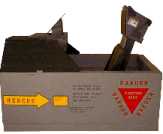
Cygnus-1: Single board
Computer
Developer: Brian Fuesz
Year: Late 1980s/Early 1990s |

The Cygnus-1 is a single board parallel computer developed as a
hobby by Brian Fuesz for use in the F-25A Flight Simulator. The
computer is based upon the 68000 processor, as well as additional
processors to be added through the boards 32-bit data bus. The
machine demonstrates its creators determination to build a complete
simulator using the cheap Motorola processors rather than Intel
models. In a time when the cost of RAM made it obtainable only by
the rich, the Cygnus-1 was forced to make do with a memory limit of
just 256k SRAM. The basic OS was stored on a flash upgradeable
EPROM. This allowed the author to rewrite the software in
conjunction with hardware development.

The hardware is nothing without software and it is here that the
Amiga took pride of place. Its low-cost made it the perfect
candidate for software development, programming and compilation of
the Cygnus-1's executable code in C. Specialist utilities were then
created to convert the AmigaDOS load files into a form that the
prototype board could understand.
The Cygnus-1 took several years to develop, while the PCB
(Printed Circuit Board) was tested, modified and altered, before
being sent to a board manufacturer. Only two PCB units were
produced.
Cygnus-1 Feature Summary
- Motorola MC68000 Microprocessor, 8MHz or 16MHz
- 4x RS232C Serial Interface Ports
- 2x 16-bit Timers
- 2x Flash EPROM Sockets (up to 256kB)
- 2x SRAM Sockets (up to 256kB)
- Real Time Clock
- 32 byte NVRAM
- Watchdog Timer
- Multi-Master 32-bit Data Bus
- 4x LED Status Indicators
- Power-On
- Reset
- Software Controlled
- Software Controlled
- 5 VDC Power (12 VDC required for Flash Programming)
The author conducts a brief retrospective on the board, citing the
diminishing cost of the Intel PC as a reason for the project to be
abandoned in favour of faster cheaper systems. As a parallel
computer it is useful for observing parallel system design and
shows a unique computer, capable of performing tasks the original
680000 designers never thought possible. It represents how
empowering the Amiga was, allowing people to pursue their own
goals. Although the most basic Amiga is seen as out of date, even
by the Amiga community, it can still become the perfect setup for
programmers interested in developing on classic hardware.
Read the AHG interview with Brian
Fuesz
BACK
Last Update: 22/6/2002
|













